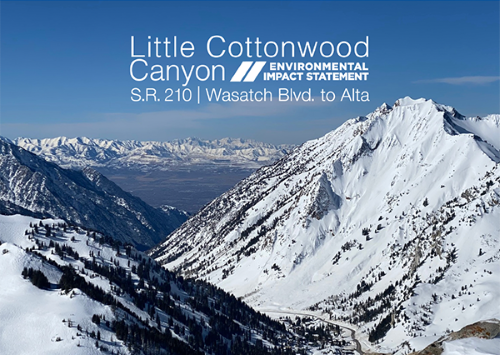The Utah Department of Transportation identified two “preferred alternatives” to improve transportation in Little Cottonwood Canyon in a draft Environmental Impact Statement or EIS issued on June 24 – alternatives that deliver mobility and reliability benefits while minimizing impact on water quality, air quality, plus visual/noise affects, among others.
[Above photo by Utah DOT]
Along with a 45-day public comment period on the EIS – which ends on August 9 – the Utah DOT said in a statement that it plans to host an in-person public open house and a hearing on July 13 to review both alternatives: events that will be livestreamed and recorded as well.
Based on its technical analysis – a process started three years ago – Utah DOT identified the Enhanced Bus Service in Peak-Period Shoulder Lane as the alternative that “best improves” mobility for the project, while the Gondola Alternative B is alternative that best improves transportation reliability.
The Enhanced Bus Service in Peak-Period Shoulder Lane Alternative offers bus-only shoulder lanes on State Route 210 from North Little Cottonwood Road to the Bypass Road for peak travel times. With this alternative, bus service is removed from congestion and able to pass slower moving traffic in the general-purpose lane, providing direct service to each destination. Of the alternatives examined, this bus option offers the fastest travel time and the second lowest cost. Meanwhile, pedestrians and bicyclists could use the improved shoulders when the buses are not operating, the agency said.
The Gondola B alternative would construct a base station approximately one mile from the mouth of Little Cottonwood Canyon and offer direct service to each destination. Each gondola could hold up to 35 people and travelers could expect a cabin to arrive every two minutes. The Gondola base station includes 1,500 parking spaces, reducing the need for passengers to use bus service from the mobility hubs. It also can operate “independently” of S.R. 210, avoiding delays related to snow removal, avalanche mitigation, crashes, slide offs, and traffic.
The Utah DOT added that while the Gondola B alternative creates the highest “visual impacts,” it minimizes effects on wildlife movement, climbing boulders, and the area’s watershed compared to the other alternatives. It is also the more expensive of the two options – clocking in at $592 million, with an annual winter operation cost of roughly $7.6 million. In addition to the preliminary preferred alternatives, the EIS highlights other elements within the project to support each alternative. These include snow sheds (concrete structures built over the highway to keep it clear of snow in case of avalanches); mobility hubs (larger-capacity park-and-ride lots with transit service); widening and other improvements to Wasatch Boulevard; tolling or single occupancy restrictions; addressing trailhead parking and eliminating winter roadside parking above Snowbird Entry 1.
